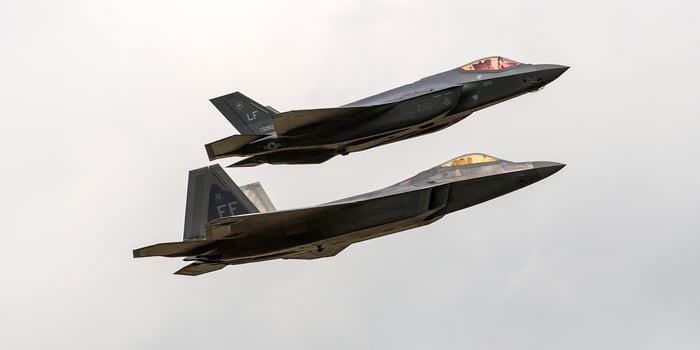Lockheed Martin (LMT 1.82%) is reportedly talking to Air Force officials about an updated version of its F-22 Raptor that would borrow heavily from the F-35 joint strike fighter, a potentially cost-efficient option for government officials concerned that the nation's air wing will not be up to the challenge posed by Russia and China in the coming decades.
The idea of a hybrid aircraft, first reported by Defense One, is described as one of several options being shopped to the Pentagon and its allies. The pitch, if successful, would potentially lead to an operational aircraft much quicker than a new fighter competition, and at a lower cost. It would also effectively preserve Lockheed's lucrative current stranglehold on U.S. fighter aircraft contracts.

Lockheed Martin-made F-22 and F-35 flying together at an air show in the United Kingdom. Image source: Lockheed Martin.
Lockheed did not comment on the Defense One report.
Both futuristic and outdated
While F-35 issues are more well-known, the F-22 was also a troubled program. Lockheed Martin in the 1990s beat out Northrop Grumman (NOC 2.23%) to build a new generation of air superiority fighters and delivered an aircraft capable of besting any and all comers.
But by the mid-2000s, when the F-22 first entered service, the Pentagon was engaged not in Cold War-type struggles with superpowers but rather against insurgent groups and makeshift militaries that lacked modern air support. A ban on exports, coupled with the Pentagon's tepid interest, created a catch-22 where reduced orders caused the price per unit to rise, but the rising cost led to a further reduction in orders. The Pentagon had initially envisioned ordering 750 aircraft at a cost of more than $26.2 billion, but only 195 were built before production halted in 2011. To date none has flown in combat.
By the time production was halted, Lockheed and the Pentagon were focused on the F-35, which was developed as more of a multirole fighter. Lockheed had beaten out Boeing (BA -0.05%) to win the joint strike fighter competition.
The F-22 had different issues. The plane had been developed in the early days of the digital revolution and carries a less sophisticated suite of sensors and mission computing hardware. It also uses a fragile radar-absorbing skin that has proven to be high-maintenance.
There is some precedent to the Pentagon relying on updates. Defense One notes that what Lockheed is proposing is similar to what McDonnell Douglas (now a part of Boeing) did with the multirole fighter F/A-18 Hornet. The updated F/A-18F Super Hornet derivative first took flight in 1995, nearly 20 years after the F-18, and remains a Navy workhorse today.
Keeping it in-house
Lockheed is almost certainly pitching the hybrid design as a best of breed, combining the top features of both aircraft into one super-plane. In reality, the plane would hopefully address lingering issues from both designs that have U.S. war planners worried they might not have adequate firepower in a future battle against Russia or China.
The Raptor would benefit from replacing its troublesome skin with the F-35's less-delicate structural fiber, as well as the newer plane's advanced tech. And borrowing from the F-22 could address criticism that the F-35, though only now ramping up toward full production, lacks the speed and endurance to go head-to-head with advanced enemy fighters and is overly dependent on refueling aircraft.
Though a fighter competition with a fresh design could generate more revenue than a revamp, for Lockheed Martin modernizing the F-22 would be appealing because it would keep its rivals out of the fighter business. The company is believed to already be working on a modified F-22 to sell to Japan, but Northrop Grumman has dropped hints it has a next-generation stealth fighter concept in development, and is said to be weighing entering its own design into the Japanese competition. Boeing, manufacturer of the 1970s-era F-15 and F-18, recently won a major Navy drone competition and would likely be eager for a chance to compete to produce a new fighter should the opportunity arise.
The plan does carry some risk for Lockheed Martin, however. A reinvigorated F-22 that solves some of the original design's flaws could elbow into some of the F-35 use case, thanks to its faster speed and potential ability to carry larger missiles. That could cut into demand for the F-35, which right now is expected to generate more than $1 trillion worth of revenue for Lockheed Martin and its subcontractors over the next half century.
Give the customer what they want
Despite the risk, Lockheed Martin is taking the right step in pitching an F-22/F-35 hybrid. The company over the last two decades has established itself as the dominant force in attack aircraft, and aviation is a major factor in making Lockheed the largest -- and at 35.8 times trailing earnings, the most highly valued -- pure-play defense contractor. To remain on that perch, Lockheed Martin needs to anticipate the Pentagon's future needs.
While U.S. military spending has risen in recent years, the Pentagon has acknowledged those hikes cannot continue indefinitely. Given the ongoing cost of F-35 procurement and the need to fund development of Northrop's new B-21 bomber, the Air Force is unlikely to want to commit to a whole new program. If Lockheed Martin can convince the Air Force it can revamp the F-22 quickly and affordably, it's likely to find military officials receptive to the idea.
In pitching an overhauled F-22, Lockheed Martin is attempting to win the next big aircraft competition before it even begins.





